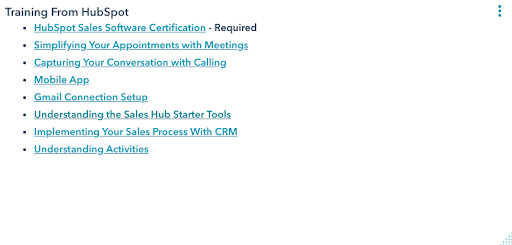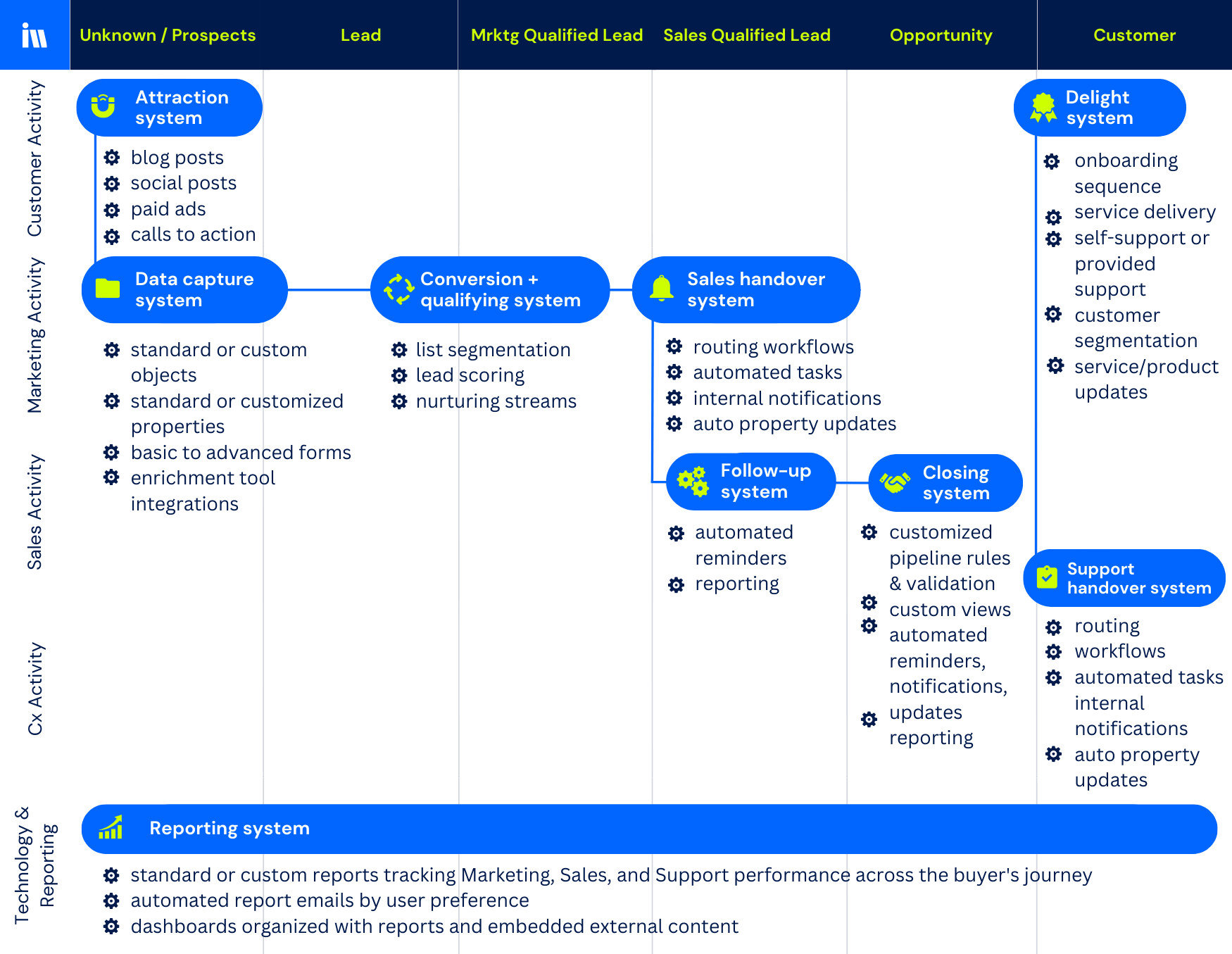National Mortgage Broker Migrates from Mortgage iQ & Total Expert to HubSpot CRM
INTRODUCTION Mortgage broker consolidates and migrates three teams into HubSpot.
Instrumental Group was introduced to Cardinal Financial as they were considering a variety of software solutions. They were working through a competitive evaluation and wanted visibility into how to handle key obstacles within an implementation plan.
Throughout the subsequent discovery and assessment it became clear that HubSpot would be able to offer a highly viable solution. While alternatives with industry-specific offerings appeared attractive at first blush, deeper evaluation revealed many organizations conclude.
They needed a robust software that could be easily crafted to meet their specific organization, not their industry. HubSpot's ability to bend to meet their unique needs was a big win, and we would be tasked with leading them through that implementation project.
Cardinal needed to accommodate Retail, Wholesale, and Consumer Direct across thousands of team members. Each team had their own requirements and unique workflow. Our plan attacked their biggest priorities: onboarding, migration, integration, configuration, team roll out training, and optimization.
PROJECT OVERVIEW
CHALLENGE Big staff within multiple teams operating in different software.
Cardinal Financial is a large organization with well-established operations. They needed a solution that was custom-fit for each team. They needed to move and integrate a lot of data and endpoints. They also needed agile training and support, with the ability to support a large number of team members across the nation.
Their teams were operating in different technologies, really causing issues with unmatched capabilities, desperate data, and a lack of holistic visibility.
- Wholesale was using Mortgage iQ as their CRM
- Retail was using Total Expert as their CRM
- Consumer Direct was already using HubSpot, but not all teams
- A host of other software had to sync data into HubSpot
The resulting challenges from this disconnected tech stack were palpable. They were hoping to address a list of issues and achieve substantial efficiencies by consolidating and streamlining their teams and operations with a single source of truth. Their team explained their top challenges as:
- Limited ability to track status, lack of data & reporting
- Inability to assign tasks out to other departments
- Inability to collaborate between resources and teams
- Gaps in analytics and insights
- Over-allocation with service due to gaps as defined
- Estimated 50% inefficiency and assumed revenue leakage
- Unnecessary slowness in ability to service customers
SOLUTION Replatforming and centralizing with HubSpot.
The implementation plan detailed a phased approach to rolling out priority teams and technology re-platforming. The implementation was to be executed over a 6-month timeline, with 6 critical steps for success:
- Discovery
- System Design
- HubSpot Architecture
- Data Migration & Integration
- Team Rollout Training
- System Optimization
Our plan was a multi-team approach, with team members from Cardinal, HubSpot, and Instrumental Group all set to contribute based on respective strengths and abilities.
Step 1: Discovery
Complex projects require a structured discovery process. The ability to assess the current state as well as map out the desired end state is critical to ensure ideal functionality.
Our recipe for Cardinal was to leverage the best and brightest solutions architects from both HubSpot and Instrumental Group in this step. We set out through a series of research-focused time blocks and planning calls:
- Prep & Access
- Stakeholder Alignment
- CRM Audits
- Discovery Sequence
- User Story Development
This recipe was applied to three teams in an overlapped timeline based on organizational priorities. We accommodated Sales, Marketing, and Recruiting teams for Wholesale and Retail to setup a collaborative single-system functionality to our design process.
Step 2: System Design
This is where we set the plan for a robust implementation that meets all of the organization's requirements. We took the learnings and user stories developed during discovery and applied them to Architecture Map.
The Architecture Map allows us to visualize how customers, internal team members, technology, and data all flow and operate within a single system. This visual diagram allows us to ensure all processes can be fulfilled while helping our clients understand the inner workings of HubSpot in support of their goals.
The Architecture Map is built into swim lanes, organizing activities and triggers along the customer journey.
- How prospects experience the sales process
- Business development activity along the way
- CRM activity, including attribution, qualification parameters, automation, workflows, and reporting criteria
- All technology leveraged throughout the journey
- Lifecycle progression throughout the journey for automation triggers
The image below is an example of an Architecture Map, simplified and representative only. [click to open enlarged version]
Step 3: HubSpot Architecture
Architecture is defined through the previous steps. At this point the project came down to implementing to specifications. Critical elements were accomplished to ensure the configuration could serve:
- Marketing operations, from awareness to conversion, to nurturing and qualification for sales handover for Retail and Wholesale offerings
- Sales operations, from qualified lead to sale with complex lead routing and customized sales pipelines for each team
- CRM development for relationship management and record customization to serve all users as well as requirements for CRM data migration and API integration with complimentary software required to complete processes
Again, this work was staggered over the timeline to serve the priority launches of different teams and divisions.
The Cardinal marketing team also made massive contributions during the architecture step, leveraging HubSpot email and landing page templates to effectively recreate all of their existing emails and conversion paths.
Step 4: Data Migration & Integration
CRM Data Migration
Our team was responsible for effectively migrating all records and history from both MortgageIQ and Total Expert. While the first step was technically completed during discovery, here's how the process looked for each CRM:
- Step 1: Migration Audit & Field Mapping: The technical exercise of mapping all required fields at each record type in each CRM, cross-referencing, and outlining related CRM development requirements.
- Step 2: Field Configuration: Record-by-record field creation and organization to ensure all data had the appropriate place to land in HubSpot CRM.
- Step 3: Data Migration: We reworked the two data exports from each CRM, reconciling headings and naming conventions for successful import in HubSpot. The HubSpot CRM import capabilities made things a snap once the formatting was aligned.
- Step 4: Delta Migration: We managed a real-time delta migration throughout the period of overlap, ensuring all new activity and records were accurately passed into HubSpot.
- Step 5: Validation and Testing: We reviewed the migrated data together, ensuring accuracy. Everything checked out, the data was successfully moved into HubSpot in the proper fields.
API Integrations
Again, a massive contribution from the Cardinal technical team. Their team took on all integration work, mapping out directional syncs between a variety of existing software applications via API. In total, here's the list of software integrated with HubSpot:
Step 5: Team Rollout Training
Our training methodology also aligns closely with HubSpot. We have adopted their preferred method of Change Management, ADKAR. We customize training curriculums to build awareness, create desire, develop knowledge, foster ability, and reinforce change and adoption. We'll plan a phase beyond this project that focuses on reinforcement specifically. For this project, we agreed to the following steps:
- Step 1: Change Management Plan: We knew we needed to work together to execute an internal communication campaign. Goals included raising awareness, setting expectations, and generating a desire for change. Our training workbook detailed the steps, and communication began in the later stages of implementation.
- Step 2 - System Tours: We started the rollout with a series of trainings with admins, tech team, and primary stakeholders from each team. As the keepers of the system, it was important for this group to understand every inch of HubSpot to ensure we were truly ready for the larger team rollout.
- Step 3 - Role-Based Training: Our next step was to host two follow-up training sessions with the sales team to answer questions and provide support. Each session included preparation assignments, including content to cover, resources, and desired impact. Aligning team training based on priorities and feedback is key to successful adoption, which is why we customize training sessions for impact.
- Step 4 - Software Training: An onboarding requirement for HubSpot, we included a series of software orientation calls to ensure team members were aware of the complete capabilities of the different Hubs.
- Step 5 - Documentation: We were also careful to document the entire system and CRM procedures. We created a library of training resources for refreshers, future reference, and new employee onboarding. All documentation and training videos were labeled and filed inside their HubSpot file manager for fast reference.

Step 5: System Optimization
With the implementation and roll out complete, we moved into an optimization period. This must-have extension to any complex re-platforming project ensures successful activation by addressing a number of important priorities:
- Additional and extended training and support for internal admins and users
- Performance audits and maintenance to ensure successful operation and data validity
- Data hygiene to address duplicates, enrichment, associations, routing, and assignments remained clean
- Nice-to-have punch list items that came up during discovery but weren't included in scope.
